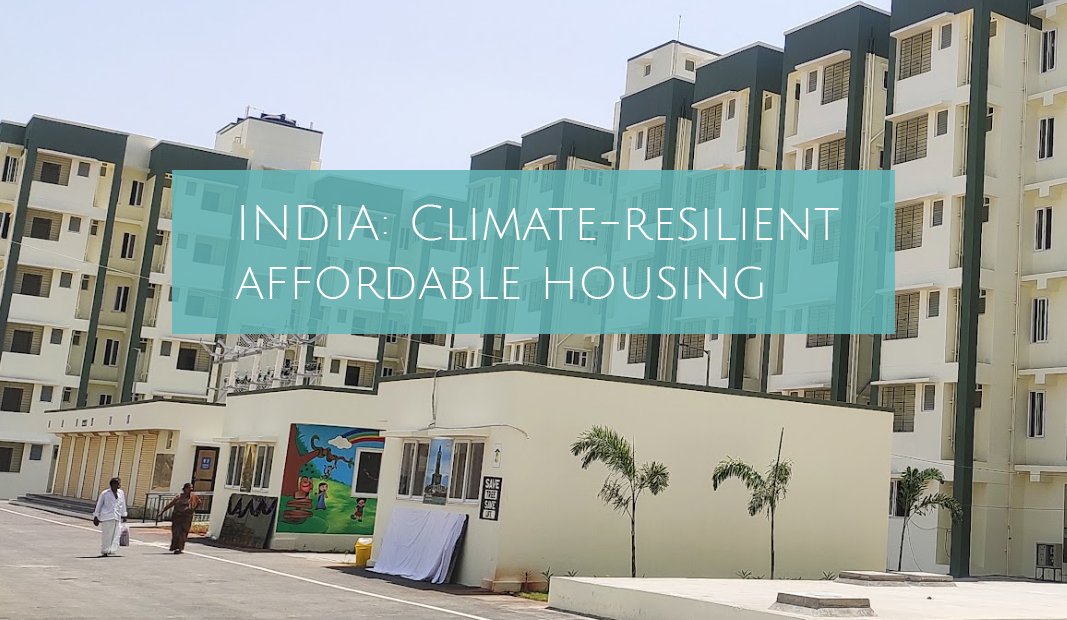When developers hear the word “sustainable” they often equate it with skyrocketing building costs. But the idea that it’s not possible to build affordable housing and also incorporate sustainable design is a myth, according to Gayathri Sivakumar, from LEAD Consultancy and Engineering Services*. In particular improving thermal comfort and climate resilience is very achievable with a negligible impact on construction budgets.
Ms Sivakumar was the project coordinator of an innovative Light House Project (LHP) in Chennai, Tamil Nadu, that aimed to show just how much can be achieved using a combination of passive architectural design and more sustainable materials.
Conducted in collaboration with Pithavadian and Partners Architects, and with GBPN as a knowledge partner, the Chennai Light House project was developed in response to a Global Housing Technology Challenge staged by the Ministry of Housing and Urban Affairs, Spearheaded by Deutsche Gesellschaft für Internationale Zusammenarbeit (GIZ).
“The Light House projects aimed to showcase innovative technology and construction processes with the potential to reduce construction time and deliver more resilient, affordable and thermally comfortable homes for the urban poor,’ Ms Sivakumar said.
“We provided the developers with a detailed thermal comfort analysis of the existing design. Then we used technical software to simulate the readings if all of the recommendations we provided were adopted into a modified design.
“This showed that there were considerable opportunities for increased energy efficiency and improved thermal comfort and the cost was really very modest. If they adopted all of our recommendations, the total increase to the budget would be less than 2%.”

If the developers on this project adopted all of our sustainable recommendations, the total increase to the budget would be less than 2%.
– Gayathri Sivakumar
Ms Sivakumar said there was a lot of need for affordable housing in India and the government had set targets under its Pradhan Mantri Awas Yojana – Urban (PMAY-U) scheme, launched in 2015. The scheme was created to address housing shortages amongst the urban poor. The Chennai project was important because it showed that simple design modifications could make a dramatic difference to thermal comfort and were very much in reach of affordable housing budgets.
“The main objectives of the Challenge are, firstly, that designs can be mass-replicated because affordable housing needs to be constructed at a faster pace. And secondly, that they utilise sustainable materials and passive design approaches while ensuring that minimum thermal comfort standards are met for the affordable housing sector,” she said.
“There is a perception that this kind of technology might not be able to reach the poor because it’s too expensive but this project shows that it is completely feasible.”
Beating the heat through smart design
Ms Sivakumar said designing buildings that can manage thermal comfort is especially important in India because of the warm and humid climate conditions.
“Especially in affordable housing, not all of our residential spaces are 100% mechanically ventilated – we don’t have an integrated HVAC (Heating, Ventilation, and Air Conditioning) system. This means we mainly depend on natural or fan-forced ventilation,” she said.
“This design had adequate daylight and the walls were constructed using autoclaved aerated concrete (AAC) blocks, because they have good thermal transmittance values – meaning they provide good heat insulation.
“The design also included proper shading elements like the horizontal or the vertical shading devices for all the windows, and the roof was covered with external white painting to reflect the heat. There will still be more opportunities for improvement and the developer indicated that they would be very interested in incorporating these into future projects where they would have an opportunity to consider them at the design stage.”
Sharing learnings with the government and building sector
 Anand Sachithanantham, Team Manager for Climate Smart Buildings (CSB) Cell, South India, said the Light House project had been able to operate as a living lab, with hundreds of visitors attending the site to learn about how the new technologies had been used.
Anand Sachithanantham, Team Manager for Climate Smart Buildings (CSB) Cell, South India, said the Light House project had been able to operate as a living lab, with hundreds of visitors attending the site to learn about how the new technologies had been used.
“People were sceptical about the new technology so this gives them a chance to learn how it can work. Government officials from different states and from various departments want to use this technology so they come. Southern Railway has visited. These activities are happening regularly even after construction has finished,” he said.
“More than 250 college students, officials from government organisations and industry sectors have visited from all over India to learn about the technology. In this way, the building sector is already benefiting from the innovations demonstrated by the project because it acts as a live demonstration project.”
He added that the improved thermal comfort of the buildings was noticeable even during construction and had been praised by the new residents.
“Even when we were using an apartment temporarily as an office, we can feel the outside heat will not affect us,” he said.
“We have also interviewed the beneficiaries who have moved into the apartments and they feel without even a fan they can occupy the house in the daytime. This is important because in Chennai’s climate, you need air conditioning. But with this kind of construction, they don’t have the monthly burden of that cost out of their expenses.”

The project was recognised by India’s Prime Minister, Narendra Modi, who inaugurated the Light House Project in Chennai on 26th May, 2022 on its successful completion, ahead of five other LightHouse Projects in India.
Mr Modi said the six lighthouse projects involved in the challenge would give a new direction to housing construction in India.
“These light house projects will be constructed through modern technology and innovative processes. This will reduce the construction time and prepare more resilient, affordable and comfortable homes for the poor,” he said.
“In a way, these projects will be incubation centres and our planners, architects, engineers and students will be able to learn and experiment with new technology.”
Find out more about the design charrettes, led by GBPN’s partner, Environmental Design Solutions (EDS), in support of building developers in India. Click here.
LEAD Consultancy Services are a graduate of GBPN’s Pitch to Policy Innovation Competition,designed to give start-ups a platform to get clever ideas in front of governments where they have potential for high impact.
Share This Story, Choose Your Platform!
Stay in touch with how we’re transforming the buildings sector
GBPN runs innovative building policy reform programs in key regions around the world that aim to tackle the climate emergency by decarbonising the buildings sector. Stay up to date with our newsletter.
Stay in touch with how we’re transforming the buildings sector
GBPN runs innovative building policy reform programs in key regions around the world that aim to tackle the climate emergency by decarbonising the buildings sector. Stay up to date with our newsletter.







